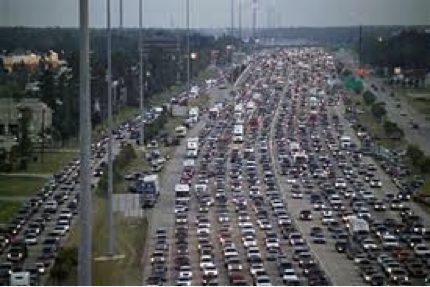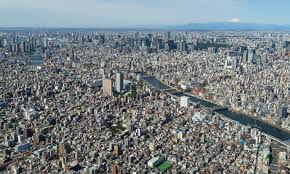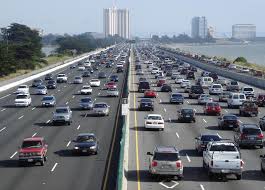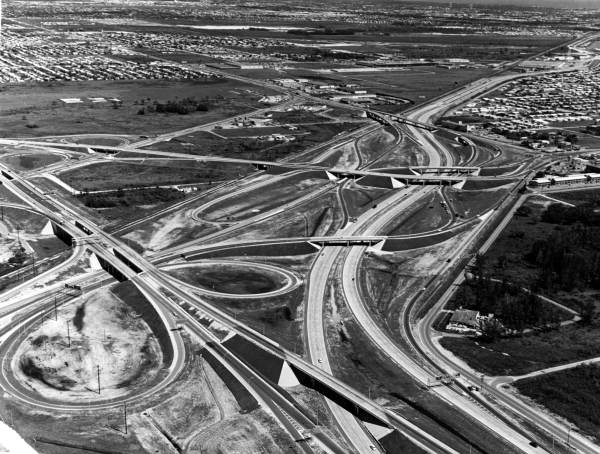Physical Address
304 North Cardinal St.
Dorchester Center, MA 02124
Physical Address
304 North Cardinal St.
Dorchester Center, MA 02124

During an urbanist twitter free-for-all last week, the thoroughly awesome term “liberty machines” was used to describe the virtues of the car. The claim was made that cars let individuals go wherever they want, whenever they want and are therefore a ‘freedom enhancing’ form of transit. This isn’t the first time I’ve heard this argument in libertarian(ish) circles. But it doesn’t tally with my experience and I’m not sure it makes any sense even within its own premise. A Personal Anecdote and a Couple Thoughts When I learned to drive way back when, it was in the great state of Texas where driving is basically a necessity. In that context, getting my license (and being economically fortunate enough to have access to a car) was certainly liberating for me after a fashion. Thinking back, though, I enjoyed far less mobility as a car bound teenager in suburban Houston than I do now living in Oakland, California. I walk to the grocery, take BART to work, bike to the gym, catch a Lyft to go out, and/or drive myself when the occasion demands. Most of my trips are multimodal and the integration of transit modes affords me far more freedom of movement than car use alone ever could. The biggest reason for this is that single occupancy vehicle use doesn’t scale as a stand alone system. Unpriced roadways are prone to hitting congestion points and, as readers of this blog are probably aware, adding lanes doesn’t help. When roads become clogged, and there are no viable alternatives, a reliance on cars becomes a constraint. And to respond to the idea that mass transit relies on government subsidies and car use does not…the technical term for that would be factually incorrect. Mass transit is more than capable of paying for itself and let’s just say highways don’t […]
Caos Planejado, in conjunction with Editora BEI/ArqFuturo, recently published A Guide to Urban Development (Guia de Gestão Urbana) by Anthony Ling. The book offers best practices for urban design and although it was written for a Brazilian audience, many of its recommendations have universal applicability. For the time being, the book is only available in Portuguese, but after giving it a read through, I decided it deserved an english language review all the same. The following are some of the key ideas and recommendations. I hope you enjoy. GGU sets the stage with a broad overview of the challenges facing Brazilian cities. Rapid urbanization has put pressure on housing prices in the highest productivity areas of the fastest growing cities and car centric transportation systems are unable to scale along with the pace of urban growth. After setting the stage, GGU splits into two sections. The first makes recommendations for the regulation of private spaces, the second for the development and administration of public areas. Reforming Regulation Section one will be familiar territory for any regular MU reader. GGU advocates for letting uses intermingle wherever individuals think is best. Criticism of minimum parking requirements gets its own chapter. And there’s a section a piece dedicated to streamlining permitting processes and abolishing height limits. One interesting idea is a proposal to let developers pay municipalities for the right to reduce FAR restrictions. This would allow a wider range of uses to be priced into property values and create the institutional incentives to gradually allow more intensive use of land over time. Meeting People Where They Are Particular to the Brazilian experience is a section dedicated to formalizing informal settlements, or favelas. These communities are found in every major urban center in the country and often face persistent, intergenerational poverty along with […]

Four years ago my wife and I decided to take our son to a special and slightly unusual restaurant to celebrate his birthday. We were in Tokyo at the time and gave the taxi driver what we thought was the address for the restaurant – it had names and numbers on it. Cabbies in Tokyo, and in Japan in general, are renowned for their courtesy, the cleanliness of their cabs, and their driving skill. We were very surprised, therefore, when our driver suddenly pulled over and told us that “the restaurant is somewhere around here,” let us off, and drove away. After several minutes of search, we did manage to find the restaurant around the corner about a block or so away. We had a great meal, but the memory of that experience has always been something of a puzzle – until now. This summer we returned to Tokyo for a family vacation, and while relaxing in our hotel room I found myself thumbing through a guide book we had brought along, Japan Made Easy, in which I found this startling statement: “Tokyo … has thousands upon thousands of streets, but fewer than one hundred of them have names.” A quick check of Google Maps seems to confirm this assertion. (Hat tip to Jeremy Sapienza). More than One Way to Address a Letter This raises some obvious questions, such as how one addresses a letter. The guide says: …[T]he addressing system in Japan has nothing whatsoever to do with any street the house or building might be on or near. Addresses are based on areas rather than streets. In metropolitan areas the “address areas” start out with the city. Next comes the ku, or ward, then a smaller district called cho, and finally a still smaller section called banchi. This […]

As an economics professor, I often witness the surprise of my students when I explain how something as important as the market for food or clothing is self-regulating. True, there are quality and safety regulations that attempt to control potential hazards “around the edges” of these vital markets, but by far the heavy lifting is done by competition among rival firms in the same industry. Trying to sell tainted food or shoddy clothing in a competitive market without special privileges will either put you out of business or make you very quick on your feet. And I get great satisfaction when I see students realize that advertising, free entry, and entrepreneurship, in the context of economic freedom, are what keep goods and services safe, cheap, and of good quality. Witness what happens when drugs and prostitution are prohibited: overly concentrated, dangerously mixed narcotics and significantly higher rates of sexually transmitted diseases, both accompanied by violence and corruption. Here government intervention thwarts self-regulation. The Nonmarket Foundations of the Market Process In the past dozen years or so, as a result of my research interest in the economy of cities, which was sparked by my discovery of the writings of Jane Jacobs, I’ve come to appreciate more and more the nonmarket foundations of the market process. Some of this has been reflected in previous Wabi-sabi columns that were concerned with social networks (most recently last week but also here). Without norms that say, for example, treating strangers fairly and trading with them is good, or that lying to and stealing from strangers is bad, human well-being couldn’t have soared to the heights of the past 200 years, especially the last 60. Now obviously none of this would have happened either without the widespread acceptance of private property, freedom of association, and the […]
Commercialism is blamed for most of the evils that plague society, inside and out of India. In the Indian city of Coimbatore, roads have become narrower and traffic more intense. There is not enough space for pedestrians. Many residents blame the city’s rising level of commercialization. Are these people correct? If they were, the world’s most commercial cities would be the least livable. But anyone with a modicum of education or travel experience knows this is not true. The cities with the most economic freedom, commercial enterprise and prosperity–think Hong Kong, Singapore, London, Sydney and Vancouver–also have the highest living standards. Similar studies show that the cities with the lowest living standards, meanwhile, are in countries that are developing, or that are suffering under repressive, anti-capitalist regimes (think Caracas, Venezuela, the world’s most dangerous city). Nevertheless, it is clear that the most commercialized Indian cities have become less livable in some important ways, such as by suffering from more congestion. So, what is going on? It is true that people migrate to cities with more commercial enterprise. It may seem that such “crowding” is unpleasant. But people are migrating to these cities precisely because there are more shops, hospitals, schools, leisure spaces and other amenities. The fact that there is already a heavy concentration of people in these cities is an important factor also, since that means there are more potential employers and business associates. Alas, the existence of people somewhere lures yet more people. Indeed, it is hard to think of a neighborhood where real estate prices have significantly fallen because of population growth. Such neighborhoods may have become more crowded…but that does not mean they are less livable. Moreover, vast population growth and crowding are not the same. Population density is defined as the number of people living on […]
Brussels, Belgium–I had recently moved from Los Angeles, my home of twenty years, to Brussels. It would be my first time living in a traditional city since becoming interested in urban design. So I was constantly looking for little urban insights and pleasures on the ground. For instance, I immediately noticed that housing prices here are roughly half of what I encountered in Los Angeles. Within a few weeks of my arrival, the bombings of Brussels occurred. The atrocity raises some interesting questions in regards to urbanism—are there certain urban designs that can prevent or discourage terrorism? Should the threat of terrorism influence the design of our cities? How would it? While terrorism may leave us shocked and breathless, it’s worth remembering that traffic deaths greatly outnumber deaths due to terrorism. In sheer numbers of lives lost and saved, cars are the bigger culprit. Terrorism, for its part, exacts a great toll paid in fear as well as loss of life and limb. What makes a city resilient in the face of terrorism? Walking The more ways one can move about the city, the more resilient it will be in the face of crisis. But, these options are not equal; cars are big compared to the space available for them—if everyone were to drive, no one would move. Here, man in his humblest form is king—we are always ready to walk, several miles if need be, without the aid of any special operator or infrastructure. Density and proximity ensure walking home is a reasonable or even routine affair. Walking loses its appeal, however, as travel distances increase, especially for the less physically able among us. And as much as walkability is ideal, many cities are just not suited for it, in their current state. Work is too far to reach via […]
Browsing through peoples’ posts of their favorite things to do in Houston, there’s a recurring theme of eating out. USA Today called Houston “the dining-out capital of the nation”: on average, we eat out more often than any other city in the country, at the second-lowest average price (Zagat). The Chronicle claims Houstonians eat out a third more times per week at 20 percent lower cost than the national average, with 9,000 area restaurants to choose from (which also makes us one of the nation’s leaders in restaurants per capita). Finally, I’ve talked to tons of people who have moved away from Houston, and one of the first things they mention missing is the restaurants. So it’s definitely one of the great strengths of Houston, but also one that raises skepticism from anybody who hasn’t lived here: why would Houston have more or better restaurants than anywhere else? What’s so special about Houston? I think there are set of factors that have come together to create the “perfect storm” of great restaurants in Houston: Diversity. Start with Houston having a very diverse population from all over the globe, so there’s plenty of people available to start restaurants in their native ethnic cuisine. Not a whole lot of cities can say that. I think a lot of that is related to being the capital of the energy industry, which is an inherently global industry. That plus being a major port city and proximity to Latin America and Cajun Louisiana. Lack of zoning. Houston’s open development culture makes it easy for anybody to start a restaurant. Plenty of inexpensive space and not a lot of regulations/permitting. The freeway network. This may seem to be an odd factor, but think about it. We have a very well developed freeway network compared to […]

Surprise!! I’ve had the intent to wrap-up the Rothbard The Urbanist series for a long time, and it’s been sitting on my todo list for over 6 years. I want to thank Jeffrey Tucker, then at mises.org, and now at FEE.org and liberty.me for enthusiastically granting permission to reprint excerpts from For A New Liberty. Murray Rothbard’s 1973 classic can be downloaded free from Mises.org as pdf, and audio book read by Jeff Riggenbach. This chapter is also discussed by Bryan Caplan as part of an econlog book club series on For A New Liberty. It’s been a while, so you may want to catch up on the first six posts: Rothbard the Urbanist Part 1: Public Education’s Role in Sprawl and Exclusion Rothbard the Urbanist Part 2: Safe Streets Rothbard the Urbanist Part 3: Prevention of Blockades Rothbard the Urbanist Part 4: Policing Rothbard the Urbanist Part 5: Diversity and Discrimination Rothbard The Urbanist Part 6: Traffic Control We pick up in the heart of chapter 11: “The Public Sector, II: Streets and Roads” to expand on a subject core to Market Urbanism: the pricing of highways, and the consequences of a system where politics, special interests, and top-down planning have incarnated a dysfunctional system severely disconnected with bottom-up pricing signals necessary to be sustainable. Tragically, Rothbard’s insights on these subjects have been mostly neglected for over 30 years, while apologists for sprawl and automobile dominance have nearly monopolized the conversation among free-market advocates. We begin the section with Professor Rothbard’s acknowledgement of what sprawl apologists turn a blind eye to, yet urbanists on the left are keenly aware. Government intervention, fueled by special interests and old-fashioned progressive ideology, massively subsidized the highway system and crowded-out otherwise viable railroads. As a result, we have an overbuilt highway system, urban neighborhoods were eviscerated, suburbs spread far-and-wide, privately […]
Both Vermont Senator Bernie Sanders and New York reality television personality Donald Trump have based their presidential campaigns in part on the issue of trade. Both of them oppose free trade policies like the North American Free Trade Agreement and the pending Tran Pacific Partnership, arguing that free trade has resulted in American jobs going overseas, leaving American workers worse-off. To remedy this situation, Trump has proposed declaring China a currency manipulator and imposing duties on Chinese-made goods, while elsewhere he’s advocated a 35 percent import tax on items made in Mexico and a 20 percent tax on all other imported goods. Sanders has also advocated imposing tarrifs on countries that manipulate their currencies to subsidize exports. To counter both candidates’ narratives of heartless corporations offshoring American jobs or unscrupulous foreigners “stealing” jobs that belong to American workers, economists and commentators from across the political spectrum have compiled impressive arrays of statistics proving that free trade actually benefits everyone. But they didn’t have to do so much. There are already examples, right now, of protectionist legislation that explodes the myths of the Trump and Sanders crowds. Since 1978, the “Buy America” provision of the Surface Transportation Assistance Act has forced transit agencies and passenger railroads like Amtrak and commuter rail services to have around 60 percent of the equipment and structural components manufactured in the United States if they want federal funding for their projects, unless they apply for and receive a waiver. Has this provision protected American workers? Does the United States now have a thriving rail equipment industry capable of competing with European, Japanese and Chinese companies, bearing out Alexander Hamilton’s “infant industry” argument? No. According to Metro Magazine, the Buy America provision makes “significant supply-chain disruptions” likely because the American market share for bus and train components […]

Cities, for most of human history, were dumb. At least, that’s what the “smart cities” movement might lead you to believe. Over the past few years, a chorus of acquisitive multinational tech corporations, trend-savvy politicians, and optimistic developers—an odd mixture of former SimCity players, in all likelihood—has come to sing of technology’s potential to solve urban problems. Through implementation of technologies like augmented physical infrastructure, central command centers, and information exchange, proponents of smart cities argue that information technology offers new solutions to old problems like trash collection, public health, and traffic congestion. While the movement’s ideological variations are many and varied, a focus on top-down smart city solutions has ultimately distracted urban observers from the bottom-up smart city revolution that’s already underway. In his 2014 book Smart Cities: Big Data, Civic Hackers, and the Quest for a New Utopia, scholar Anthony M. Townsend paints a troubling picture of the former in Rio de Janeiro’s modestly titled Center for Intelligent Operations. Developed by IBM, the center acts as a hub for hundreds of surveillance cameras and sensors. At best, the center achieves little more than, in Townsend’s words, “looking smart.” At worst, the center seems to be a regression back to twentieth century centralization. Townsend’s explorations of Songdo, South Korea, a city purported to be both centrally-planned and smart, hardly quells these concerns. The discussion leaves the reader with a healthy skepticism of top-down smart city solutions. Other criticisms have made the top-down smart city feel less like something out of 1984 and more like something out of Terry Gilliam’s Brazil. In a couple of recent posts, Emily points out the roadblocks presented by poor incentives and a lack of market signals, both for politicians and high-ranking public servants. For similar reasons, both parties lack the incentives to implement […]